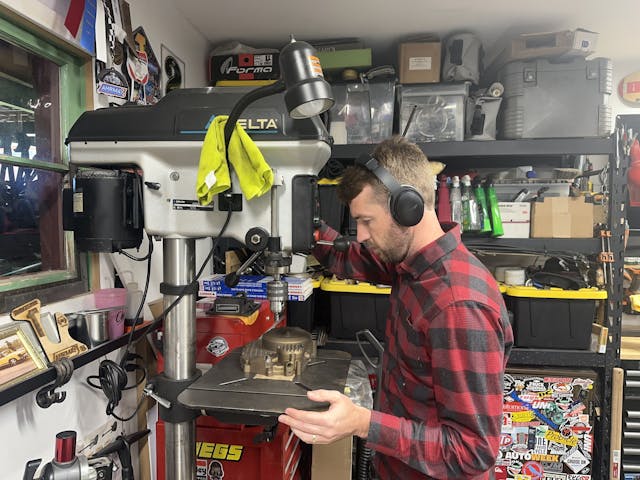Modern repair technology has come a long way. We as humans have the ability to restore function to so many broken or damaged things. It’s amazing, but we should also understand what cannot be repaired. The one major example that people often forget is the human ear. Our hearing is a delicate thing that once gone is typically gone forever. Luckily it is pretty easy to prevent damage, and the old cliché about an ounce of prevention holds true here. For about £175 you can have four great options for all-day comfort and safety.
Hearing protection, like most personal safety items in the shop, comes in various levels of protection. Having to use the same piece of equipment for every situation could cause you to use none at all due to the annoyance of stopping to find the right hearing protection. That search can sometimes take longer than the project you need hearing protection for. Short jobs are just as damaging as big jobs though. Tinnitus and hearing loss do not care about your timeline.

There are a couple of terms we need to define before we are able to compare and understand what makes one solution better than another for certain tasks. The first is decibel and how we measure sound. Sounds pressure waves traveling through air bump up against our ear drums, which vibrate against three bones – the malleus, incus, and stapes – which comprise our inner ear. Those vibrations are interpreted by our brains. Parts of that system can get damaged by too much or constant pressure that comes from loud noise. Just 70 decibels for an extended period of time can be damaging. For reference, that is roughly equivalent to a hoover running six feet away.
The second term to know is NRR, or Noise Reduction Rating. This is the metric through which the efficacy of hearing protection is judged. The higher the NRR, the lower the transfer of sound through the hearing protection to the ear drum. When shopping for hearing protection, this number should be easy to find and high is better for most situations, but depending on the job you might not need the highest form of protection. In fact, having the four types of hearing protection listed below ought to cover most home shop needs.
Active noise-canceling headphones

Sometimes the noise is not much more than the dull roar of machines running in another room or a modern power tool running at arm’s length. It might add up to a dull roar that can be tolerable, but why tolerate what you don’t have to? Active noise cancellation is technically not hearing protection but in the right situation, it sure feels like it.

Active noise cancellation does not insulate our ears from the surrounding noise. Instead, there is a microphone that picks up the surrounding noise and then produces the opposite sound waves via the speakers in the headphones to neutralize the surrounding noise to the wearer’s ears. It’s a fairly complicated system that has dropped significantly in price over the years and now there are sub-£50 options that work fairly well for general wearing. Best suited for steady background noise like an air compressor filling the tank.
Custom-moulded earplugs

The next step in your hearing protection journey is to go see an audiologist. Just like how you wouldn’t take advice about brushing your teeth from a 30-something writing about cars on the internet, you really shouldn’t take my word as gospel for how to best take care of your hearing. A professional has access to tools and information I don’t.


This is why I will tell you about my favorite thing an audiologist did for me: stuffed my ears full of foam. Well, that might be a little misleading, but it’s mostly accurate. They took a mould of my ears and then used it to create reusable and extremely comfortable in-ear hearing protection specific to my ears. The NRR on most custom-moulded earplugs like these are in the 30–32 range, but without interfering with taking a helmet or glasses on and off. They are low-profile and comfortable for long-duration wearing like at a racetrack. They are my personal favorite for working in the pits at a track or fabricating in the shop where I might be doing small amounts of work with an angle grinder or die grinder and don’t want to have to take hearing protection off and on. A middle-ground option before full custom-moulded earplugs is reusable triple-flange plugs.
Over-ear muffs

The old standard. Rather than trying to fit the sound blocking inside your ear, muffs create a barrier on the outside. These can be found in various levels of NRR and most importantly can be found in a multitude of sizes, including some designs specifically for youth. For a quick job, or if having something inside your ear canal for a long duration is uncomfortable, these are the solutions. The easy on-and-off nature, along with durability, makes it obvious why these have been the gold standard for a long time.
Like all the other options here, fit is important. Ensure that the band over the top is adjusted properly to have the muffs sit over your ears and that the seal around the edge has good contact with your head. Even just the crack in the seal from wearing glasses can be enough to limit the effectiveness of over-the-ear protection. A bonus is how these also keep your ears clean, which can be nice when doing a lot of grinding or in a very dusty environment. Foam ‘roll and stuff’ earplugs

Interestingly, the disposable option comes last and actually is the most effective. Foam earplugs often have the highest NRR and are the most affordable. That comes with the tradeoff of needing to be properly inserted into your ear, and having spares around due to their disposable nature is a good idea. While foam earplugs can occasionally be reused, it does open up the opportunity for ear infections if not careful. A whole bunch of these earplugs often come with a minimal price tag, so they are worth having both in the shop and in your car since they are perfect for handing to someone who might be underprepared at an event or wrenching session.
Regardless of which style of hearing protection you favor, using something is better than nothing, and having the right thing on hand makes using proper hearing protection that much easier.









